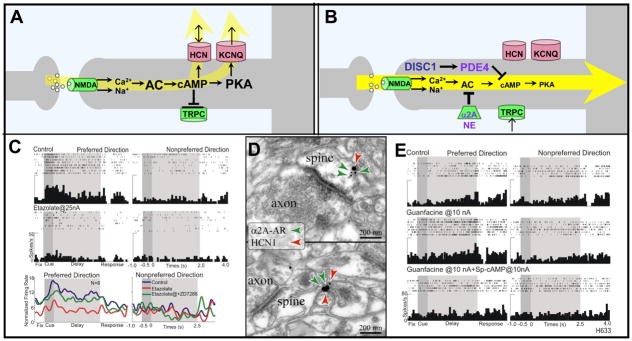Figure 3.
cAMP signaling weakens PFC network connectivity. A. A working model of cAMP signaling mechanisms that weaken network connectivity. cAMP directly increases the open probability of HCN channels, while indirectly affecting KCNQ2/3 channels via PKA. High levels of cAMP also can reduce the depolarizing TRPC current. B. A working model showing mechanisms that inhibit cAMP signaling and strengthen network connections. NE stimulation of α2A-ARs inhibits cAMP production, while DISC1 activates PDE4s to catabolize cAMP. DISC1 is shown in navy blue to highlight its genetic perturbation in some families with schizophrenia. PDE4, NE and α2A-ARs are shown in purple to emphasize their decline with normal aging. C. High levels of cAMP arising from PDE4 inhibition markedly reduce PFC network firing, which can be reversed by blocking HCN channels with ZD7288 (shown) or blocking KCNQ2/3 channels with XE991 or linopirdine (not shown). Reduced PFC network firing also has been seen following increased cAMP signaling with Sp-cAMPS or yohimbine (not shown). Adapted from [7]. D. Dual immunoelectron microscopy showing α2A-AR/HCN1 channel colocalization in the spine head (top) and the spine neck (bottom) in the superficial layers of the monkey dorsolateral PFC. Adapted from [7]. E. Iontophoretic application of the α2A-AR agonist, guanfacine, increases PFC network firing for the preferred direction, while co-application of the cAMP analog, Sp-cAMPS, reverses this effect. Adapted from [7].

